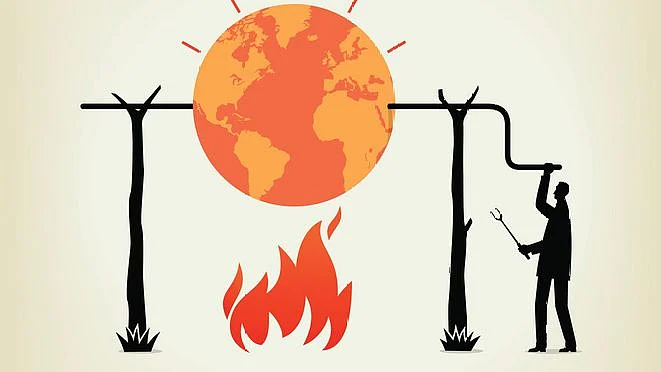With only a couple of days left for the 26th United Nations Climate Change Conference of the Parties (COP26) to convene in Scotland's Glasgow, experts have repeatedly elucidated that our present efforts to limit carbon emissions do not match up to the mounting environmental concerns in the world.
One of the objectives of the summit is to secure an agreement that adheres to the Paris Agreement of 2015, namely, its emphasis on limiting the rise in average global temperatures to well below 2°C above pre-industrial levels, aiming to plateau it at 1.5° C.
However, a nearly three-year-old report released by UN's Intergovernmental Panel on Climate Change shed light on the near inevitability of surpassing a temperature increase of 1.5° C.
As per the 2018 report, if emissions continue on their present trajectory, average global temperatures will likely reach 1.5°C above pre-industrial levels between years 2030 and 2052 — a finding that echoes UN Secretary-General António Guterres assertion that 'climate change is moving faster than we are'.
So, if global heating was to touch a high of 2°C, what would happen? And is it significantly worse that limiting heating to a peak of 1.5°C? The answer is a resounding yes.
A report by The Conversation states, "Even at 1.5°C of global heating, tough times are in store for the living planet. But the space between 1.5°C and 2°C of heating is a crucial battleground, within which risks to humanity and ecosystems amplify rapidly."
Increasing Heat Waves
A 2°C increase will have a marked impact on the number of extreme hot weather experienced around the world.
In regions situated at central latitudes, extreme hot days will be 3°C hotter at a limited increase of 1.5°C. A 2°C increase means that these areas will be about 4°C hotter, Yale Climate Connections reported.
The report also notes that about 14 percent of the world’s population would be exposed to extreme heat waves once every five years if global temperature increases are held to 1.5°C, with a 2°C rise, that percentage ascends to 37 percent.
Meanwhile, some regions in the world will expect less rain and more consecutive dry days, while others will receive more extreme floods, The Conversation reported.
Impact on Sea Levels and Ice Sheets
As per studies, at 1.5°C, by 2300, sea levels will rise by one metre. This figure will increase by 26 cm more at 2°C increase, The Conversation reported.
Compared to 1986-2005, the sea-level is risked to increase from 0.26 meter to 0.77 metre if Earth’s temperature rises to 1.5 degree Celsius, as per the ‘1.5˚ Report’. Meanwhile, small islands and coastal areas will the threat of being submerged.
Mumbai, Chennai, Vishakhapatnam, among 12 other Indian cities will be submerged three feet under the sea by the end of the 21st century, as per NASA, based on the IPCC report.
As per the Yale Climate Connections report, by 2100, sea levels will mount by 0.36 to 0.87 meters with a 2°C increase.
The rate at which the Greenland and West Antarctic Ice Sheets are declining also gets significantly impacted between the two increases.
With a 2°C increase in global temperatures, the Arctic Ocean could be rendered ice-free once in the summer of every 10 years, as opposed to once every 100 years in case of a 1.5°C increase.
Coral Reefs at Risk
1.5°C of warming would mean a loss of 70 percent and 90 percent of our coral reefs, a catastrophic result for millions of ocean creatures and human livelihoods, The Conversation reported.
However, this percentage will increase to 99 percent if the temperature increases further to 2°C, meaning not just catastrophe, but the extinction of thousands of species.
The Effect on Biodiversity
6 percent of insects, 8 percent of plants, and 4 percent of vertebrates are projected to disappear from their climatically determining geographic range by 2100 with a 1.5°C increase, Yale Climate Connections reported.
Same goes for polar bears and other species which live and depend on sea ice for food.
With a further increase, these numbers double, effecting 18 percent of insects, 16 percent of plants, and 8 percent of vertebrates by 2100.
A 2°C rise in global temperature would result in 13 percent of the world's terrestrial land area to transform its ecosystems, risking their collapse and being a threat to human civilizations.
Even though the earth has heated by 1.1 degrees Celsius since 1850-1879, an increase of 0.2 degrees happened between years 2011 and 2015. The last four years were the warmest in the global temperature record, The Conversation reported.
Despite this knowledge, and the added impact this adversity can have on areas such as poverty, displacement and health, many nations are still further away from limiting global heating to 2 degrees Celsius, much less 1.5 degrees Celsius.
(With inputs from The Conversation)
(At The Quint, we question everything. Play an active role in shaping our journalism by becoming a member today.)
